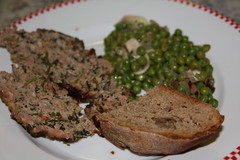
Meatloaf dinner
Just the idea of meatloaf conjures an image of TV dinners, Depression-era cookbooks, and eating for cheap. It’s not an inspiring image for a foodie, but I figured there must be a way to make a slightly more modern, healthier version of those dinners and still save money. So last night for my weekly Tuesday dinner club, I decided to make a gourmet version of meatloaf and green peas and add up the total cost.
Here’s what I made with the cost of ingredients:
Last year, The New York Times featured a piece called Fancy Meatloaf in the food section – the author was having Nora Ephron over for dinner—so I knew this was not going to be my mom’s meatloaf with the ketchup and the smiley face made of olives and gherkins. I’m a pretty amateur bread maker, but I wanted to do this whole meal as cheaply and as homemade as possible, so I threw together a loaf of whole wheat bread the night before and let it rise. And how can you have a meatloaf dinner without green peas on the side?
I had the basics already in the fridge (leftover bread, flour, milk, oil, butter, eggs, vinegar, salt and pepper), so adding to that I spent:
For the meatloaf:
1 pound ground chuck (I bought local, non-hormone treated beef): $7.77
1 pound ground veal: $5.64
1 link, hot pork sausage: $1.00
1 cup white wine: $10/bottle (and you can drink it with dinner!)
For the peas:
1 package green peas: $1.19
2 slabs house-cured bacon from the local deli: $2.50
1/2 pound mushrooms: $1.50
For the bread, in addition to the flour, I needed:
1 packet dry yeast: $.75
1 can beer $1.50
TOTAL: $31.85, for a meal that serves about six people. That averages out to just over $5 per serving, including a glass of wine. Not bad!
